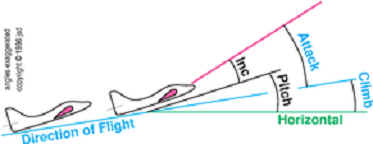
Three Contributions to Angle of Attack
As mentioned earlier, it is difficult to directly perceive angle of attack. Fortunately, there are three other quantities that can be perceived, and together they determine the angle of attack. They are:
•Pitch
attitude, which is defined
•Angle of climb, which is just the angle between the flight path and the horizontal.
•Angle of incidence, which is the angle at which the wings are attached to the fuselage.
These quantities are related to the angle of attack by a very simple formula
Pitch Attitude + Incidence = Angle of Climb + Angle of Attack
This
relationship is illustrated in

Extending the flaps has the effect of increasing the incidence